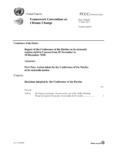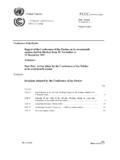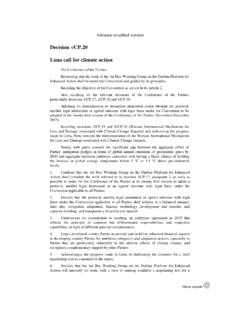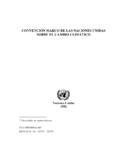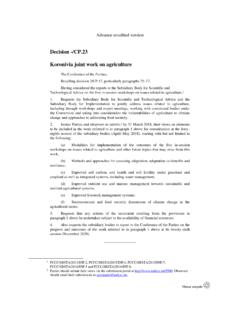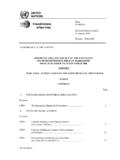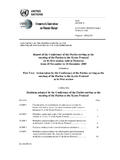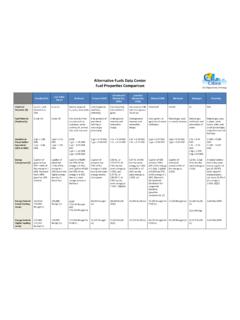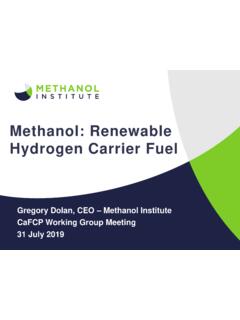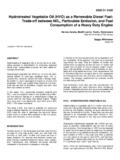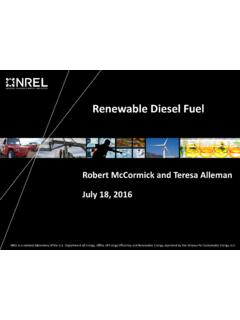Transcription of GHG Accounting for Grid Connected Renewable Energy …
1 INTERNATIONAL FINANCIAL INSTITUTIONS TECHNICAL WORKING GROUP ON GREENHOUSE GAS Accounting IFI TWG - AHSA-001 GHG Accounting for Grid Connected Renewable Energy Projects Version Date: July 2019 IFI TWG - AHSA-001 GHG Accounting for Grid Connected Renewable Energy Projects Version Date: July 2019 2 of 8 TABLE OF CONTENTS Page 1. OVERVIEW .. 3 2. DEFINITION .. 3 3. SCOPE FOR CALCULATIONS .. 3 4. PROJECT OUTPUT .. 4 5. BASELINE EMISSIONS FACTORS .. 4 6. METHODOLOGICAL APPROACH FOR THE COMMON DATA SET .. 5 7. CALCULATION OF THE OM .. 5 8. CALCULATING THE BM .. 6 9. COMBINING THE OM AND BM TO CONSTRUCT THE CM EF .. 7 10. CALCULATING BASELINE EMISSIONS .. 8 IFI TWG - AHSA-001 GHG Accounting for Grid Connected Renewable Energy Projects Version Date: July 2019 3 of 8 1. Overview 1. This note sets out a harmonized approach for assessing the mitigation benefits, or net greenhouse gas (GHG) emissions, of Renewable Energy (RE) projects in accordance with the International Financial Institution (IFI) Framework for a Harmonized Approach to Greenhouse Gas A Technical Working (TWG)2 Group of IFIs has agreed to use a common set of emissions factors for GHG Accounting of electricity production from Renewable Energy (RE) The purpose is to harmonize GHG Accounting through the application of common emissions factors to RE GHG calculations.
2 Further iterations of this approach note will include the treatment of off-grid RE activities. 2. Definition 1. For this document, the definition of Renewable Energy (RE) for electricity production follows the RE project typology defined by the Common Principles for Climate Mitigation Finance Tracking:4 (a) Wind power. (b) Geothermal power. (c) Solar power (concentrated solar power, photovoltaic power). (d) Biomass, liquid biofuels, or biogas power. (e) Ocean power (wave, tidal, ocean currents, salt gradient, etc.). (f) 2. If the pre-investment facility has not reached the end of its technical life, the approach set out in the IFI Approach to GHG Accounting for Energy Efficiency Projects6 shall be followed. 3. Scope for calculations 3. GHG calculations should take the following points into consideration, where applicable/appropriate: 1 Available here.
3 2 The IFI TWG for this methodology includes technical specialists from ADB, AfDB, AFD, EBRD, EIB, GEF, GIB, NIB, NEFCO, IDB, IFC, and WB, with support from the UNFCCC secretariat; to be widened to include more IFIs as work progresses. This note will be reviewed and updated periodically by the TWG. 3 This approach is generally consistent with similar approaches to account for GHG emissions from a broader set of power generation projects. 4 Available here (link 1; link 2). 5 Pumped storage is not considered Renewable Energy for the purpose of this document. 6 Available here. IFI TWG - AHSA-001 GHG Accounting for Grid Connected Renewable Energy Projects Version Date: July 2019 4 of 8 (a) Construction emissions for RE projects may be excluded, where forms of Renewable Energy are generally acknowledged to have low construction/lifecycle emissions. (b) Include GHG emissions from large reservoirs associated with hydropower projects.
4 (c) Include biomass feedstock-related life-cycle (d) Include geothermal fugitive emissions. 4. Project Output 4. Assumptions for power generation capacity (MW) and project Energy output (MWh) should be based on the project appraisal documentation and the due diligence documentation of IFIs. 5. Baseline Emissions Factors 5. The main principles and assumptions for the baseline emissions factors include: (a) Electricity produced from Renewable sources and supplied to a grid, unless otherwise specified8, will avoid emissions that would otherwise be generated wholly or partly from more carbon-intensive sources. (b) For the purpose of promoting greater harmonization, the IFI GHG Accounting TWG (IFI TWG) maintains a common dataset containing Default Emissions Factors (DEFs) for countries and interconnected grids where applicable. The default emissions factors apply to electricity generation in a country and currently do not consider the impact of interconnections with neighbouring countries.
5 The impact of a project on a country with interconnections is determined on a case-by-case basis by the IFI. Where IFIs co-finance such projects, harmonisation of the assumptions is encouraged. The approach to determine default emissions factors will be further refined as more data/information become available for countries with a significant level of interconnection with neighbouring countries (including countries, which are part of a power pool). (c) The common dataset of DEFs will be updated at-least once in two years under the responsibility of the TWG. Where an IFI has conducted its own country baseline study, the results of this study may be submitted to the TWG for consideration of inclusion in the common dataset during future annual updates. (d) In those cases, where a project is replacing specific planned or existing generation capacity, each IFI is free to conduct its own assessment, which may be shared with the TWG.
6 In all other cases, the DEF approach and the common dataset described will apply. 7 Life-cycle emissions may include emissions due to storage, biomass collection, processing and transportation. 8 See Scope for Calculations (section 3). IFI TWG - AHSA-001 GHG Accounting for Grid Connected Renewable Energy Projects Version Date: July 2019 5 of 8 6. Methodological Approach for the Common Data Set 6. The common dataset containing DEFs is constructed using a Combined Margin (CM) for the grid that is comprised of an Operating Margin (OM) and a Build Margin (BM). The OM and BM are terms defined under the clean development mechanism (CDM)9 for grid Connected electricity generation from Renewable sources. (a) The OM represents the cohort of existing power plants whose operation will be most affected (reduced) by the project. (b) The BM represents the cohort of the prospective/future power plants whose construction and operation could be affected by the Renewable Energy project, based on an assessment of planned and expected new generation capacity.
7 7. Calculation of the OM 7. The International Energy Agency s (IEA) Energy statistics database10 provides country specific information on electricity generation from gas, oil, coal and other fuels and related CO2 emissions that are used to calculate the OM emissions factor of most of the countries in the common 8. In principle, the OM consists of generation from the power plants with the highest variable operating costs in the economic merit order dispatch of the electricity system. Natural gas and oil-based power plants have the highest variable operating costs, followed by coal. Nuclear power, hydropower, co-generation plants and other sources of power including waste to Energy and other renewables are typically must run or low cost and therefore contribute to the OM only under special circumstances. 9. For the purposes of the common dataset, the default OM is defined as the plants producing the most-costly generation of the fossil fuel generation mix.
8 Fossil fuel power plants in many countries provide firm power generation in base load or are must run and typically provide low cost power. To avoid including these power plants in the OM, only the top 50% or most costly half of the total fossil fuel generation mix is used. Gas and oil generation are the most-costly and are the first to enter the OM. Due to fluctuations in oil and gas fuel prices, these sources are not differentiated and are assumed to contribute equally to the 9 ACM0002: Grid Connected electricity generation from Renewable sources available here. 10 The IEA CO2 Emissions from fuel Combustion Statistics provide information on fuel combustion and CO2 emissions by sector, including electricity generation, for 142 countries and territories. A 3-year rolling average of the most recent statistics is used to smooth annual variations.
9 11 As and when country specific data becomes available to the IFIs , through their detail country studies, such information can be used to replace IEA data to calculate operating margin emission factor but applying the same principle and methodology stipulated in this document. IFI TWG - AHSA-001 GHG Accounting for Grid Connected Renewable Energy Projects Version Date: July 2019 6 of 8 OM on a pro-rata Coal-based power plants contribute to the OM only when coal generation exceeds 50% of the total fossil fuel generation 10. Other power plants enter the operating margin when non-fossil fuel generation exceeds 50% of the total generation An adjustment factor based on CDM methodology15 is used to determine the contribution of other fuels in the OM. 11. For countries not represented in the IEA Energy statistics, research from publicly available sources is used to identify the mix of gas, oil, coal and other fuels used for electricity generation and default emissions factors for each fuel type are applied to define the OM according to the methodology described above.
10 8. Calculating the BM 12. The IEA maintains a world Energy model (WEM) that is the principal tool used to generate detailed sector-by-sector and region-by-region projections for the publication of the World Energy Outlook (WEO). Through the WEM, it is possible to project the CO2 emissions of new electricity generation under various scenarios. New electricity generation comes from the cohort of power plants commissioned from the start of the forecast period. The common dataset uses an average of the annual emission intensities of new electricity generation projected over the next 8 years under the New Policy Scenario (NPS) of the most recent WEO as an estimate of the BM16. The NPS assumes a continuation of the Energy policies already adopted by governments and implementation of current commitments and plans and incorporates assumptions on fuel prices, technology costs and technological progress.
